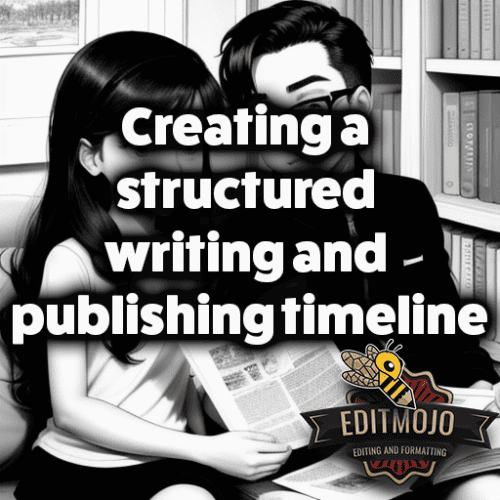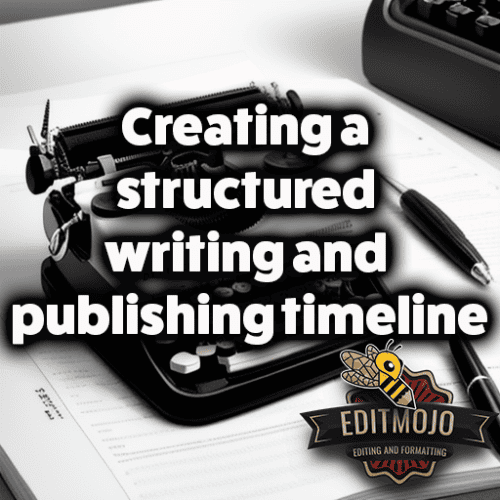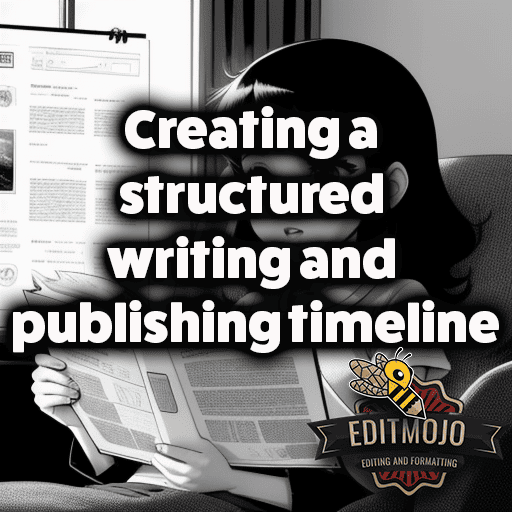Creating a structured writing and publishing timeline
Creating a structured writing and publishing timeline. In the creative world, chaos often precedes creation. However, when it comes to writing and publishing, an organized approach can often yield the best results. The purpose of this article is to guide you through the process of creating a structured writing and publishing timeline, a roadmap that can help you navigate your journey to becoming a published author with less stress and more success.
Key Takeaways Table
| Key Point | Takeaway |
|---|---|
| Need for a Structured Writing and Publishing Timeline | A structured timeline can provide improved organization, enhanced productivity, and consistent progress monitoring. |
| Breaking Down the Writing and Publishing Process | The process involves several stages: idea generation and development, research, writing the first draft, editing and revising, preparing for publication, and the publishing process itself. |
| Creating a Personalized Writing Schedule | Personalized writing schedules are crucial and should take into account individual writing pace, personal commitments, and the nature of the project. |
| Building a Comprehensive Publishing Timeline | A publishing timeline includes steps such as final revisions, book design and formatting, pre-publication marketing, and post-publication marketing. |
| Utilizing Tools for Structured Writing and Publishing | Tools like project management software, writing applications, and scheduling apps can aid in creating a structured timeline. |
| Adapting to Challenges and Changes in the Timeline | Flexibility is key to managing challenges that might disrupt your timeline. |
| Case Studies of Successful Writing and Publishing Timelines | Structured timelines have been successfully used by authors like J.K. Rowling and John Grisham. |
Understanding the Need for a Structured Writing and Publishing Timeline
Writing and publishing a book is no small feat. It requires more than just an idea and the will to write. It requires a clear plan, structure, and commitment, all of which can be provided by a structured writing and publishing timeline.
Why is such a timeline important, you might wonder? Here are three main reasons:
- Improved Organization: Keeping track of where you are and where you need to go becomes significantly easier with a well-laid-out plan. Think of it as a roadmap, guiding you through the often-confusing landscape of the writing and publishing world.
- Enhanced Productivity: Having a clear understanding of deadlines and time allocation can help you stay focused, maintain motivation, and ultimately produce better work.
- Consistent Progress Monitoring: With a structured timeline, you can keep an eye on your progress, make necessary adjustments, and celebrate small victories along the way.
However, without such a timeline, you may find yourself struggling with unmet deadlines, forgotten ideas, and diminishing motivation. Just imagine driving through a new city without a map or GPS, and you’ll understand why having a structured timeline is so crucial.

Breaking Down the Writing and Publishing Process
Understanding the writing and publishing process is the first step in creating your timeline. It’s like learning about the stops and landmarks before embarking on a journey. The process generally involves the following stages:
- Idea Generation and Development: This is where it all begins. You brainstorm, play around with ideas, and choose a concept to build your book around.
- Research: Depending on the nature of your book, you might need to gather data, interview people, or study specific topics.
- Writing the First Draft: This is when you finally start putting your ideas into words. Remember, first drafts don’t have to be perfect; they just have to be written.
- Editing and Revising: Now, it’s time to refine your work, correcting grammar, improving style, and enhancing the narrative.
- Preparing for Publication: This includes tasks like final proofreading, book design, and formatting.
- The Publishing Process: This involves choosing a publishing route, whether traditional or self-publishing, and then taking the necessary steps towards getting your book in the hands of readers.
Creating a Personalized Writing Schedule
Creating a writing schedule is a highly personalized process. Everyone writes at their own pace and has their own set of commitments. Stephen King, in his book On Writing, reveals that he aims to write 2,000 words a day, while Ernest Hemingway famously aimed for 500. It’s about finding what works for you.
Here are some steps to help you create a flexible and realistic writing schedule:
- Determine your daily word count goal based on your writing speed and availability.
- Set aside specific times for writing, making sure they are periods when you can work undisturbed.
- Schedule regular breaks to avoid burnout.
- Include days for rest and reflection to keep your creative juices flowing.
- Finally, stay flexible and adaptable. Life happens
, and it’s important that your schedule can accommodate unexpected events.
Sticking to this schedule may be challenging, especially on days when writer’s block hits or motivation wanes. But remember, consistency breeds success. As Roald Dahl famously said, “A little bit of something is better than a lot of nothing.”

Building a Comprehensive Publishing Timeline
Publishing a book involves a number of steps that should be thoughtfully considered and scheduled. Here’s a general overview:
- Final Revisions and Proofreading: This is your last chance to make sure everything is perfect. Consider hiring a professional proofreader to ensure your manuscript is free from errors.
- Book Design and Formatting: This includes creating an engaging book cover and formatting your book’s interior. This can be a time-consuming process, so plan accordingly.
- Pre-publication Marketing: Start building buzz about your book. This might involve social media promotion, setting up a book launch, or sending out review copies.
- Publication Date and Post-publication Marketing: Choose a publication date and continue marketing efforts post-publication to keep the momentum going.
Your timeline will depend on whether you choose traditional publishing or self-publishing. Traditional publishing generally takes longer, with the timeline stretching from a year to two years, while self-publishing offers more control and can be accomplished within a few months.
Utilizing Tools for Structured Writing and Publishing
Thankfully, there are many tools out there that can aid in creating a structured timeline. Project management tools like Trello, writing software like Scrivener, and scheduling apps like Google Calendar can make the process more manageable.
Choosing the right tool depends on your needs. Trello is excellent for visual organization, Scrivener is designed specifically for long-form writing projects, and Google Calendar can sync across multiple devices, keeping you updated on your schedule wherever you go.
Adapting to Challenges and Changes in the Timeline
No journey is without bumps and detours. The key to managing challenges, be it writer’s block, unexpected life events, or publishing delays, is flexibility.
When faced with these challenges, revisit your timeline, make necessary adjustments, but also remember to be kind to yourself. Stress and pressure can hinder creativity. The purpose of your timeline is to provide structure, not to confine you.
Case Studies of Successful Writing and Publishing Timelines
There are countless authors who have successfully used structured timelines. For example, J.K. Rowling meticulously planned the Harry Potter series using hand-drawn tables. On the other hand, John Grisham follows a strict writing routine, waking up early to write before his day job when he was starting out.
These examples prove that a structured timeline can be a game-changer in an author’s journey. The key is to find what works best for you and your creative process.
Conclusion (Creating a structured writing and publishing timeline)
Creating a structured writing and publishing timeline can seem daunting at first, but with a clear understanding of the process, the right tools, and a bit of flexibility, it becomes an invaluable asset. It’s your roadmap to turning your ideas into a published book. So why not start creating your own today?
Feel free to share your experiences, ask questions, or share your own successful writing and publishing timeline in the comments below. Your journey might just inspire someone else.

References
For those interested in diving deeper into the world of writing and publishing, here are a few resources worth checking out:
- Scrivener – A comprehensive writing tool.
- Trello – A project management tool useful for planning and organization.
- Google Calendar – A scheduling app to keep you on track.
Top Five Questions and Answers (Creating a structured writing and publishing timeline)
| Question | Answer |
|---|---|
| Why do I need a structured writing and publishing timeline? | A structured timeline can improve your organization and productivity, provide a clear overview of your progress, and help manage your time effectively. |
| How do I create a personalized writing schedule? | Determine your daily word count goal, set aside specific times for writing, schedule regular breaks, and remain flexible to accommodate unexpected events. |
| What does a publishing timeline involve? | It includes steps such as final revisions and proofreading, book design and formatting, pre-publication marketing, and post-publication marketing. |
| What tools can help me create a structured timeline? | Tools like Trello for project management, Scrivener for writing, and Google Calendar for scheduling can be very helpful. |
| How do I manage challenges that disrupt my timeline? | Be flexible and ready to adjust your timeline as needed. Remember to be patient and kind to yourself during challenging times. |
